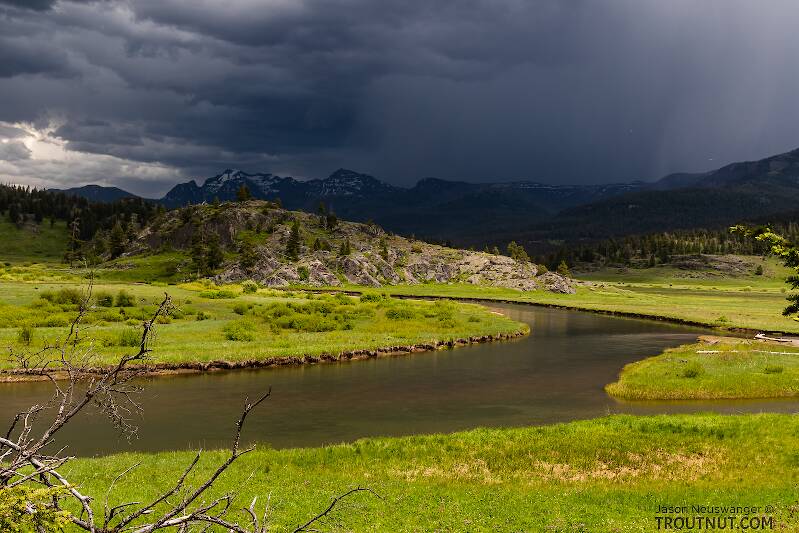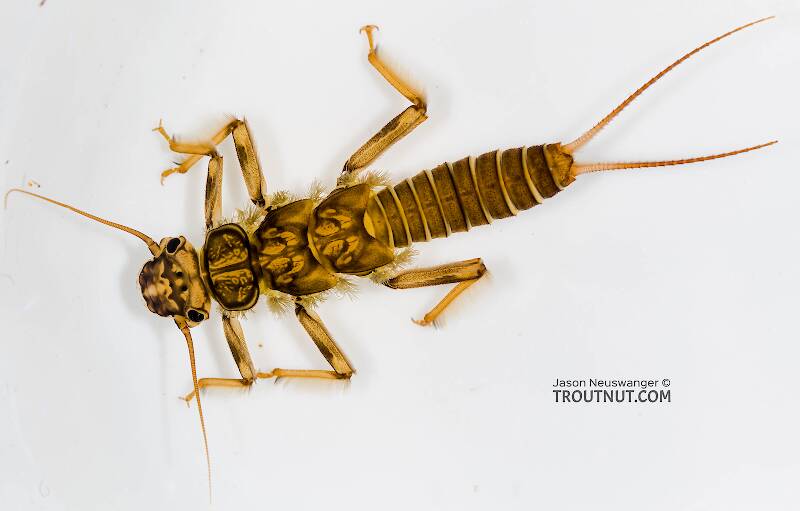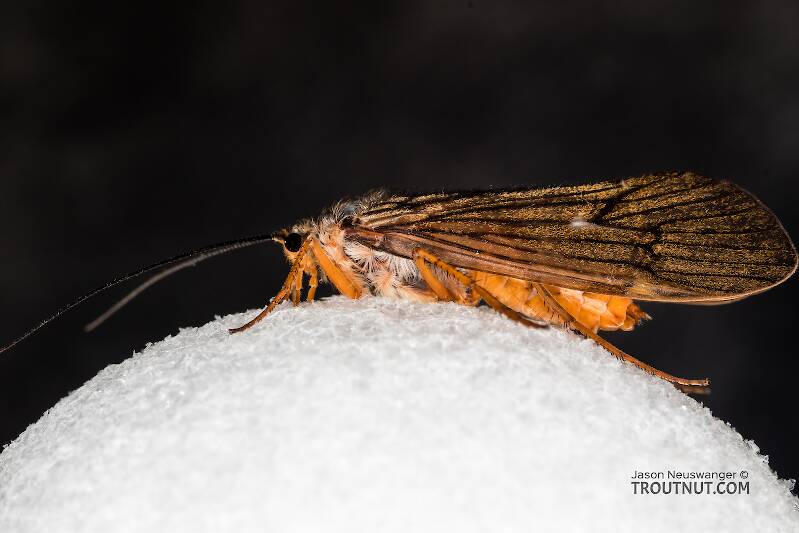
Salmonflies
Pteronarcys californica
The giant Salmonflies of the Western mountains are legendary for their proclivity to elicit consistent dry-fly action and ferocious strikes.
Featured on the forum

Troutnut is a project started in 2003 by salmonid ecologist Jason "Troutnut" Neuswanger to help anglers and
fly tyers unabashedly embrace the entomological side of the sport. Learn more about Troutnut or
support the project for an enhanced experience here.
This topic is about the Insect Order Trichoptera
Some say caddisflies are even more important than mayflies, and they are probably right. The angling world has taken a while to come to terms with this blasphemy. Caddis imitations are close to receiving their fare share of time on the end of the tippet, but too many anglers still assume all caddisflies are pretty much the same.Caddis species actually provide as much incentive to learn their specifics as the mayflies do. There is just as much variety in their emergence and egg-laying behaviors, and as many patterns and techniques are needed to match them. Anglers are hampered only by the relative lack of information about caddisfly behavior and identification.
Example specimens
Mesanomad on Jul 6, 2009July 6th, 2009, 4:39 am EDT
Was on Penn's yesterday. A lot of small (#18)caddis cases (typical of Grannoms; tubular, 4-sided) on underside of rocks. Given the number of cases, I'd assume it's an important insect. Any idea what species this is? Thanks.
Taxon on Jul 6, 2009July 6th, 2009, 5:35 am EDT
Steve-
There are (at least) 5 species of Brachycentrus present in PA, B. incanus, B. lateralis, B. nigrosoma, B. numerosus, and B. solomoni, so there are likely multiple Brachycentrus species present in Penns Creek. Having said that, my guess is that the majority of them would be B. numerosus (Dark Grannom).
There are (at least) 5 species of Brachycentrus present in PA, B. incanus, B. lateralis, B. nigrosoma, B. numerosus, and B. solomoni, so there are likely multiple Brachycentrus species present in Penns Creek. Having said that, my guess is that the majority of them would be B. numerosus (Dark Grannom).
GONZO on Jul 6, 2009July 6th, 2009, 5:45 am EDT
Steve,
Grannoms are indeed important on Penn's, and as Roger suggests, multiple species are present in the watershed. Brachycentrus numerosus, lateralis, and solomoni (at least) are reported from that immediate area. In addition, 5 Micrasema spp. (Little Grannoms) are also reported, and some lepidostomatids build 4-sided cases that are sometimes mistaken for brachycentrids. B. numerosus was the species that fly-fishing writer Chas. Wetzel nicknamed the "Penn's Creek Caddisfly." The emergence of the important Brachycentrus species is a late April/early May event on Penn's.
Grannoms are indeed important on Penn's, and as Roger suggests, multiple species are present in the watershed. Brachycentrus numerosus, lateralis, and solomoni (at least) are reported from that immediate area. In addition, 5 Micrasema spp. (Little Grannoms) are also reported, and some lepidostomatids build 4-sided cases that are sometimes mistaken for brachycentrids. B. numerosus was the species that fly-fishing writer Chas. Wetzel nicknamed the "Penn's Creek Caddisfly." The emergence of the important Brachycentrus species is a late April/early May event on Penn's.
Mesanomad on Jul 6, 2009July 6th, 2009, 6:29 am EDT
Thanks guys. Have you had much success with a cased caddis pattern? Or should I just stick with pupal patterns for this type of caddis?
GONZO on Jul 6, 2009July 6th, 2009, 7:29 am EDT
Pupal and adult patterns would certainly be the things to use during the emergence/egg-laying period, but some have success imitating the cased larvae in the early spring prior to emergence.
Mesanomad on Jul 6, 2009July 6th, 2009, 7:58 am EDT
I guess I was just thinking of what to use during the middle of the day, when not much is going on. Thought a cased caddis might be an option.
GONZO on Jul 6, 2009July 6th, 2009, 8:32 am EDT
There's often good reason that little is going on in the middle of the day in summer, but my suggestion--provided that water temps are not too high--would be to throw terrestrials (beetles, ants, hoppers) or small adult caddisfly patterns around shady bankside cover, or to seek fast-water areas to probe with "searching" nymph patterns. Although the cased larval Grannom imitations might work, I wouldn't expect them to perform much better than "generic" searching flies at this time of year. For something more specific, you might try Green Rockworm (Rhyacophila larvae) imitations, or small, fat, pale yellowish or pinkish larval imitations (to imitate drifting Glossosoma larvae that abandon their outgrown cases). Both imitations seem to have an "attractive" as well as imitative quality, and the tying can be very simple. You might want to try those in tandem, if you are into that sort of thing.
JAD on Jul 6, 2009July 6th, 2009, 9:36 am EDT
Hi Guys this is a most unusual July for Penns Creek. On a normal July day one would kick back and open a few, pepsi or coke bottles and snooze. I think I would throw stone flies and skip the Caddis till September. If you have to throw a Caddis then make it green or tan.
jaD--AKA Caddisman1
jaD--AKA Caddisman1
They fasten red (crimson red) wool around a hook, and fix onto the wool two feathers which grow under a cock’s wattles, and which in colour are like wax.
Radcliffe's Fishing from the Earliest Times,
JOHNW on Jul 6, 2009July 6th, 2009, 10:39 am EDT
"I think I would throw stone flies and skip the Caddis till September."
I'll second that emotion. Especially given the "high water" year we are having. Just remember stones are multi year growth cycles so you can fish a pretty wide variety of sizes as long as you can get them down. As for patterns it can be any pattern you like as long as it is a woven stone ( or maybe thats just me).
JW
I'll second that emotion. Especially given the "high water" year we are having. Just remember stones are multi year growth cycles so you can fish a pretty wide variety of sizes as long as you can get them down. As for patterns it can be any pattern you like as long as it is a woven stone ( or maybe thats just me).
JW
"old habits are hard to kill once you have gray in your beard" -Old Red Barn
Mesanomad on Jul 6, 2009July 6th, 2009, 1:32 pm EDT
I had a stonefly on most of the day yesterday. Just didn't do as much with it as usual. I'm kinda still in that phase of "working on nymphing," even though it might not always be the best option. I'm a glutton for punishment too, going out in the middle of the day.
GONZO on Jul 6, 2009July 6th, 2009, 2:43 pm EDT
There's nothing wrong with "working on nymphing," Steve. However, if you need a break from the middle-of-the-day doldrums that you are experiencing on larger waters, many of the little headwaters and tribs fish great at this time of year. Some of the coldest ones actually fish better through the middle of the day than they do early in the morning or late in the evening, and water that is a little higher than normal often makes them even easier to fish. Just a thought, FWIW.
Mesanomad on Jul 6, 2009July 6th, 2009, 2:50 pm EDT
No doubt. The water temp was ~64F. Not too bad. But on its way up. I probably would've fished Cherry Run at some point. Just didn't have the time. Maybe tomorrow.
JAD on Jul 7, 2009July 7th, 2009, 2:08 am EDT
I agree with Lloyd.
Hard to beat a cool MT. stream on a hot afternoon. only thing better than that is hot buns from moms oven :)
jAD
Hard to beat a cool MT. stream on a hot afternoon. only thing better than that is hot buns from moms oven :)
jAD
They fasten red (crimson red) wool around a hook, and fix onto the wool two feathers which grow under a cock’s wattles, and which in colour are like wax.
Radcliffe's Fishing from the Earliest Times,
Martinlf on Jul 8, 2009July 8th, 2009, 7:35 am EDT
OK, I can't believe that no one has suggested this yet, but try a sinking inchworm/green caddis imitation. Or a green weenie. I'll bet some fish can be caught on that fly almost anywhere in PA this time of year.
My bad: Gonzo did suggest a green caddis. But he didn't say "Green Weenie" perhaps due to his strong sense of decorum--which I don't have. So I'll say it again. Try a green weenie/green chenille inchworm.
My bad: Gonzo did suggest a green caddis. But he didn't say "Green Weenie" perhaps due to his strong sense of decorum--which I don't have. So I'll say it again. Try a green weenie/green chenille inchworm.
"He spread them a yard and a half. 'And every one that got away is this big.'"
--Fred Chappell
--Fred Chappell
Mesanomad on Jul 8, 2009July 8th, 2009, 8:58 am EDT
yea. had the weenie on yesterday. no luck. was on big fishing creek instead. tough day again. i'm starting to convince myself that these fish are seeing the same patterns over and over again. it probably doesn't help that i've been showing up in the late afternoon. so many people fishing these places anymore. crazy.
Martinlf on Jul 9, 2009July 9th, 2009, 4:03 am EDT
Amazing. But BFC has a reputation for being very tough, as has Penns. You do earn every fish. Good luck.
"He spread them a yard and a half. 'And every one that got away is this big.'"
--Fred Chappell
--Fred Chappell
Quick Reply
Related Discussions
Topic
Replies
Last Reply
13
Mar 27, 2008
by Martinlf
by Martinlf









